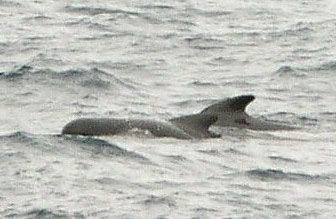

 | |||||||||
|
|
Journals 2006/2007Miriam Sutton
August 20, 2006 AM Location: Slope off Hudson Strait (60° 45' 58.56" N, 60° 43' 55.11" W) "Whales, portside," was the announcement from the Bridge this morning. I grabbed my camera and headed for the door. They were pilot whales, a pod of about a dozen, and they were beautiful. This is the first time I've seen pilot whales alive as all of my other encounters with this species were beachings along the shores of North Carolina. A few of the whales were accompanied by calves and they were frolicking about as I struggled to time my shutter releases with their surface intervals. (See Pilot Whales photo below.)
Pilot whales are similar in appearance to the bottle-nosed dolphin that is commonly seen off the North Carolina coast. Pilot whales are larger and darker in color than the bottle-nosed dolphin and their beak is blunter also. We haven't observed many whales during our research cruise and I have developed a hypothesis to address their absence. I attended an oceanography institute at the US Naval Academy earlier this summer and learned that different species of whales hear at different frequencies. (That's right. It all goes back to that wavelength and frequency knowledge base we've been working on.) Odontocetes (or toothed whales) hear on a higher frequency/shorter wavelength than mysticetes (or baleen whales). Pilot whales and dolphins are odontocetes while larger whales like the humpback and blue whales are mysticetes. Mysticetes hear on very low frequencies which correspond to very long wavelengths that can travel long distances through seawater. I hypothesize that we haven't encountered any mysticetes during our voyage because they can hear our low frequency seismic tones from afar and decide to avoid us. The odontocetes, however, are much closer before they can hear our seismic tones. Coupled with their natural curiosity, our seismic clicks and pings may actually attract the odontocetes. But, don't worry. The frequencies being used by the Geologic Survey of Canada have been tested and deemed non-hazardous for marine mammals. Today's Activity: Use an encyclopedia or the Internet to research the hearing range (or hertz range) of various animals. How does a dog's hearing range differ from a human's hearing range, or a bird's hearing range? Select other animals that interest you and discover the hertz range, or frequencies, at which they hear sound. Word of the Day: Baleen REMINDER: Record today's Sea Surface Temperature (SST) and the Air Temperature on the data table you created from the August 05 journal entry. |
||||||||
